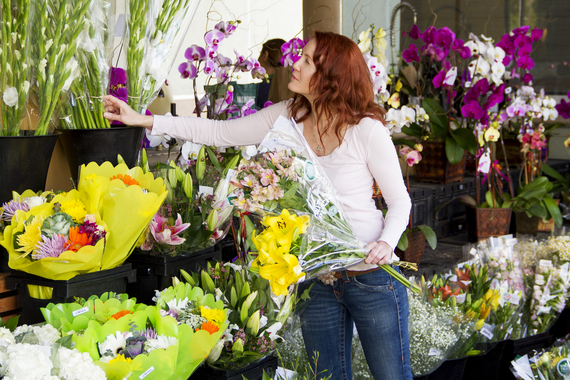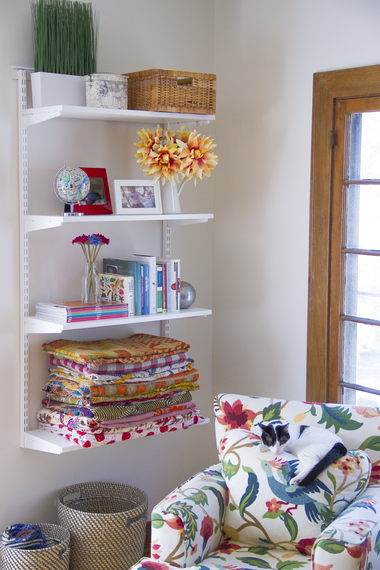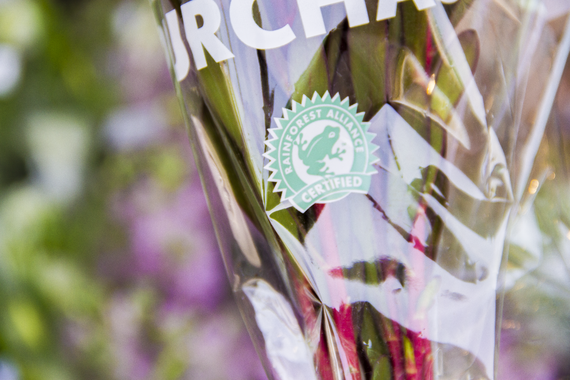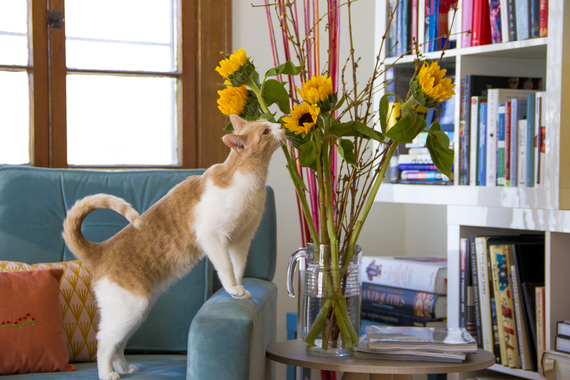The joy of flowers!
A bouquet of flowers may be one of my favorite home accents. Flowers add color, convey secret (or not so secret) messages and a flower can be found to fit your every mood. I personally love flower arrangements in unexpected places. I discovered this accidentally after receiving a bouquet of lilies from a friend. Lilies are toxic to cats, but to my cats -- used to eating kale right from my Farmers' Market bags -- lilies look like salad. Not wanting to be a part of kitty suicide, I moved the lilies to the top of my Elfa® shelves and discovered something really quite wonderful. Flowers as centerpieces are beautiful, but predictable. Flowers in unexpected places add real joy to a home, the joy we find in a good surprise.
Flowers, though, can be complicated.
Artificial Flowers
Even though I live in sunny California where flower farms are found statewide, for most of they year I use artificial flowers in my home to achieve the same effect as real flowers. As an animal-loving person there are two things to be aware of when buying artificial flowers: What they are made from and how they are made.
For hundreds of years, artificial flowers were made from silk and silk is an insect-derived material made from the cocoons of silkworms. After cocooning, the worm and cocoon are plunged into boiling water to release the threads of the cocoon which are woven into silk. The worm dies. Luckily the use of silk in artificial flowers has taken a back seat to polyester, which became the fabric of choice in the 1970s and '80s. If you're unsure whether your flowers are made from silk or polyester, simply check the tag as it's illegal to misidentify a material on a label. However, less lucky for animal lovers is the practice of dipping the raw fabric -- whether silk or polyester -- into gelatin to stiffen the material for petal formation. Gelatin is a by-product of animal slaughter, obtained by boiling skin, tendons, ligaments and/or bones in water to create a multi-purpose protein-based thickening agent. Want a good way to make an artificial flower ugly? Dip the material in a dead pig.
All is not lost, however. More and more manufacturers of artificial flowers are using Polyethylene-vinyl Acetate Emulsion (PEVA or PVA) in place of gelatin. What is this magic gelatin replacer? Elmer's Glue. Tip of the Day? All of IKEA's artificial flowers are animal-product free. Shop happy!
Fair-Trade Flowers
A rose is a rose is a rose said Gertrude Stein. A rose is also part of the $8 billion annual domestic cut flower business. Flowers are big money, and not all flowers are cut equally. Flowers are sourced from flower farms and most of the world's flowers are grown in the Netherlands, Kenya, Tanzania, Colombia and Ecuador. There are U.S. flower farms but they are not at the scale found in the industrial greenhouses and farms overseas. Many international flower farms and greenhouses are not audited. Workers at overseas industrial flower farms may be exposed to dangerous pesticides, long hours, little pay and unclean working conditions.
However, before we boycott all overseas flower farms, we should remember that flower farms are huge economic engines for developing countries. Money from flower farms is used for community development initiatives such as schools, clean water and hospitals. Flower farms are also critical to bee health. Buying flowers from bee friendly farms (marked BFF) supports healthy bee populations by providing colonies adequate food and space to reproduce. The solution is to pay attention to the flowers you buy. Look for indications on the sleeves of the flowers that they were sourced via FairTrade Standards. This means they adhere to the international protocols monitoring the cut flower industry which both protects the natural environment and workers' rights. A few of the symbols to look for are: the FFP of the Fair Flowers Fair Plants initiative; the FSI from The Floriculture Sustainability Initiative; or the frog from the Rainforest Alliance group.
I like to buy flowers from my local farmers market but if you don't have a market near you, check out your local florist and ask questions. The more we request ethically sourced flowers, grown either locally or internationally, the better the world will be.
Pet-Friendly Flowers
If your cats are like mine, they absolutely cannot resist flowers. A spring bouquet to them must seem like Elaine's "big salad" from Seinfeld because I have seen my cats literally scale walls in their desire for a tulip. Amusing on the one paw, dangerous on the other. How many times have I found a disembodied petal with bite mark evidence next to a pile of kitty throw up? Too many times for comfort. So while cats can and should eat some greens (kale and spinach are particularly good for cats), attention should be paid to the flowers you bring home as some, quite literally, will kill your feline friend.
Dog owners take heart. Dogs tend to be less interested in cut flowers but they also tend to blindly consume anything in their path. To be on the safest side, there are many lists online of flowers and plants that are toxic to our companion animals. Or you can always try my suggestion of putting your flowers in interesting and unusually high spots. Just be aware that kitties magically develop suction-cup paws when you are asleep.
This article originally appeared in Vegan Lifestyle magazine issue #18 and is available at iTunes http://goo.gl/rDCtRK



